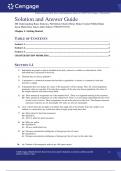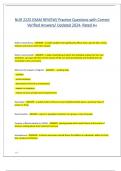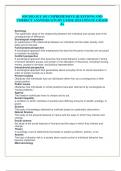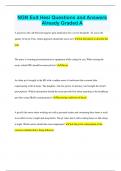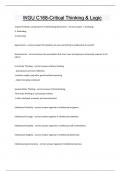Solution and Answer Guide : Brase, Understanding Basic Statistics 9e, 9780357719176 ; Chapter 1: Getting Started 1 © 202 4 Cengage. All Rights Reserved. May not be scanned, copied or duplicated, or posted to a publicly accessible website, in whole or in part. Solution and Answer Guide SM Understanding Basic Statistics , 9th Edition Charles Henry Bra ke Corrin e Pellillo Bra ke Jason Mark Dolor James Allen Seibert , 9780357719176 ; Chapter 1: Getting Started TABLE OF CONTENTS Section 1.1 ................................ ................................ ................................ ................................ .................... 1 Section 1.2 ................................ ................................ ................................ ................................ .................... 2 Section 1.3 ................................ ................................ ................................ ................................ .................... 3 CHAPTER REVIEW PROBLEMS ................................ ................................ ................................ .......... 4 SECTION 1.1 1. Individuals are people or objects included in the study, wh ereas a variable is a characteristic of the individual that is measured or observed. 2. Nominal data are always qualitative. 3. A parameter is a numerical measure that describes a population. A statistic is a numerical value that describes a sample. 4. If population does not change, the values of the parameters will not change. Thus, for a fixed population, parameter valu es are constant. If we take three samples of the same size from a population, the values of the sample statistics will almost surely differ. 5. (a) These numerical assignments are at the nominal level. There is no apparent ordering in the responses. (b) These numerical assignments are at the ordinal level. There is an increasing relationship between worst to best levels of service. These assignments are not at the interval or ratio level. The distances between numerical responses are not meaningful. The ratios are also not meaningful. 6. Lucy’s observations do not apply to all adults; they apply only to her friends. Since the sample is not random, we cannot draw any conclusions about a larger group using these data. 7. (a) Meal ordered at fast-food restaurants. (b) Qualitative . (c) All U.S. adult fast-food consumers. 8. (a) Miles per gallon. (b) Quantitative. (c) All new small hybrid cars. 9. (a) Nitrogen concentration (milligrams of nitrogen per liter of water). (b) Quantitative. (c) Nitrogen concentration (milligrams of nitrogen per liter of water) in the entire lake. 10. (a) Number of ferromagnetic artifacts per 100 square meters. Solution and Answer Guide : Brase, Understanding Basic Statistics 9e, 9780357719176 ; Chapter 1: Getting Started 2 © 202 4 Cengage. All Rights Reserved. May not be scanned, copied or duplicated, or posted to a publicly accessible website, in whole or in part. (b) Quantitative. (c) The entire Tara region. 11. (a) Ratio. (b) Interval. (c) Nominal. (d) Ordinal. (e) Ratio. (f) Ratio. 12. (a) Ordinal. (b) Ratio. (c) Nominal. (d) Interval. (e) Ratio. (f) Nominal. 13. (a) Nominal. (b) Ratio. (c) Interval. (d) Ordinal. (e) Ratio. (f) Interval. 14. Form B is better. Statistical methods can be applied to the ordinal data obtained from Form B but not to the open -response answer s obtained from Form A . 15. (a) Answers vary. Ideally, weigh the packs in pounds using a digital scale that has tenths of pounds for accuracy. (b) Some students may refuse to have their backpacks weighed. (c) Informing students before class may cause students to remove items before class. SECTION 1.2 1. In stratified samples, we select a random sample from each stratum. In cluster sampling, we randomly select clusters to be included, and then each member of the cluster is sampled. 2. In simple random samples, every sample of size n has an equal chance of being selected. In a systematic sample, the only possible samples are those including every kth member of the population with respect to the random starting position. 3. Sampling error is the difference between the value of the population parameter and the value of the sample statistic that stems from the random selection process. The term is being used incorrectly here. Certainly larger boxes of cereal will cost more than smaller boxes of cereal. 4. The sample frame consists of all students who use the college recreation center. The sample frame does not include all students enrolled in the college since some students may not use the center. 5. No. Even though the sample is random, some students younger than 18 or older than 20 may not have been included in the sample. 6. No. A random sample could include only music majors. 7. (a) Stratified. (b) No. Each pooled sample would have 100 season ticket holders for men’s basketball games and 100 season ticket holders for women’s games. Samples with, for example, 125 and 75 tickets holders, respectively, are not possible. 8. (a) Yes. Every student has a 50% chance of being selected. (b) It is not possible based on this method of selecting students. Since eve ry sample of size 20 is not possible, this is not a simple random sample. (c) Assign numbers 1, 2, . . , 40 to the students and use a random -digit table or a computer package to draw random numbers. 9. Simply use a random digits table or a computer package to randomly select four students from the class. (a) Answers vary. Perhaps they are excellent students who make an effort to get to class early. (b) Answers vary. Perhaps they are busy students who are never on time to class. (c) Answers vary. Perhaps students in the back row are introverted. (d) Answers vary. Perhaps taller students are healthier. 10. (a) Students who are absent from class on Monday cannot be included in the sample. Solution and Answer Guide : Brase, Understanding Basic Statistics 9e, 9780357719176 ; Chapter 1: Getting Started 3 © 202 4 Cengage. All Rights Reserved. May not be scanned, copied or duplicated, or posted to a publicly accessible website, in whole or in part. (b) Home schooled students, students who dropped out , or homeless students cannot be included in the sample. 11. Answers vary. 12. Answers vary. 13. Answers vary. 14. Answers vary. One possibility is to use 0, 1, 2, 3, and 4 to indicate heads and 5, 6, 7, 8, and 9 to indicate tails. 15. (a) Yes, it is appropriate, as a number can repeat itself once it has occurred. The outcome on the fourth roll is 2. (b) We will most certainly not get the same sequence of outcomes. The process is random. 16. Answers vary. We do expect at least one match on birthdays over 50% of the time we run this experiment. 17. Answers vary. Use single digits in the table to determine the placement of correct answers. 18. Answers vary. The test key would be a random arrangement of True and False responses. 19. (a) Simple random sampling. Every sample of size n from the population has an equal chance of being selected, and every member of the population has an equal chance of being included in the sample. (b) Cluster sampling. The state, Hawaii, is divided into zip codes. Then, within each of the 10 selected zip codes, all businesses are surveyed. (c) Convenience sampling. This technique uses results or data that are conveniently and readily obtained. (d) Systematic sampling. Every fiftieth business is included in the sample. (e) Stratified sampling. The population was divided into strata based on the business type. Then a simple random sample was drawn from each stratum. 20. (a) Stratified sampling. The population was divided into strata (four categories of length of hospital stay), and then a simple random sample was drawn from each stratum. (b) Simple random sampling. (c) Cluster sampling. There are five geographic regions, and some facilities from each region are selected randomly. Then, for each selected facility, all patients on the discharge list are surveyed to create patient satisfaction profiles. (d) Systematic sampling. Every 500th patient is included in the sample. (e) Convenience sampling. SECTION 1.3 1. Answers vary. For instance, some people may have a career following their passion, but with low income or a long commute. Others might be very satisfied with their career as long as the income is high. One-way commute times may be long because affordable housing is distant from the job. A working spouse could affect all three variables. Soluti on and Answer Guide : Brase, Understanding Basic Statistics 9e, 9780357719176 ; Chapter 1: Getting Started 4 © 202 4 Cengage. All Rights Reserved. May not be scanned, copied or duplicated, or posted to a publicly accessible website, in whole or in part. 2. A double -blind procedure would entail neither the patients nor those administering the treatments knowing which patients received which treatments. This process should eliminate potential bias from the treatment administrators and from patient psychology regarding benefits of the drug. 3. No, the respondents do not constitute a random sample from the community for a number of reasons. For instance, the sample frame includes only those at the farmers’ market, and Charlie may not have approached people with large dogs or those who were busy, and participation was voluntary. Charlie’s T-
shirt may have influenced responses. 4. No, the pooled sample had a fixed number of students from each block. 5. (a) No, those aged 18 to 29 in 2006 became aged 20 to 31 in 2008. The study is looking at the same generation. (b) 1977 to 1988, inclusive. 6. By 2020, the Echo generation will be aged 32 to 43, and their perception of items as necessities or luxuries might well have changed by then. 7. (a) This is an observational study. The data collection method did not influence the outcome. (b) This is an experiment. A treatment was imposed on the sheep in order to prevent heartworm. (c) This is an experiment. The restrictions on fishing possibly led to a change in the length of trout in the river. (d) This is an observational study. The data were collected without influencing the turtles. 8. (a) Sampling. (b) Simulation. (c) Census. (d) Experiment. 9. (a) Use random selection to select ten calves to inoculate with the vaccine. After a period of time, test all calves for the infection. No placebo is being used. (b) Use random selection to select nine schools to visit. After 10 weeks, survey students in all 18 schools for their views on police officers. No placebo is being used. (c) Use random selection to select 40 subjects to use the skin patch. A placebo is used for the other 35 subjects. At the end of the trial, survey all 75 subjects about their smoking habits. 10. (a) ―Over the last few years‖ could mean 2 years, 3 years, 7 years, and so on. A more precise phrase is ―Over the past 5 years.‖ (b) If a respondent is first asked, ―Have you ever run a stop sign,‖ chances are that their response to the question, ―Should fine be doubled?‖ will change. Those who run stop signs probably don’t want the fine to double. (c) Answers vary. 11. Based on the information, scheme A will be better because it blocks all plots bordering the river together and all plots away from the river together. The blocks of Scheme B do not seem to differ from each other. CHAPTER REVIEW PROBLEM S 1. Because of the requirement that each number appear only once in a given row, column, or box, it would be very inefficient to use a random -number table to select the numbers. It’s better to simply look at existing numbers, list possibilities that meet the requirement , and eliminate numbers that don’t work. 2. Alisha’s study has some problems , and the results will be anecdotal. For instance, it is not clear that the puzzles Alisha wants to download are all at the same difficulty level. Alisha’s friends who are willing to participate will likely have different levels of experience with the puzzles. Alisha’s friends are also volunteers , and the self-timing may lead to inaccurate measurements.

